A gyroscope failed on board the International Space Station Wednesday evening, but NASA says that it doesn’t pose a risk to astronaut safety. The gyroscope failed only hours after the hatch was opened between the station and the Soyuz capsule carrying three astronauts. The station’s four gyroscopes are designed to keep it oriented properly in space, but it can still work with only one functioning gyro. Even if that fails, the station can use maneuvering jets on the attached Soyuz capsules for keeping position. A previous gyro broke a year ago, and it was supposed to have been repaired, but the Columbia disaster put this on hold.
Gravity Probe B is Working Fine
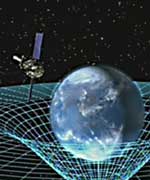
Image credit: NASA
Gravity Probe B ? a NASA mission to test two predictions of Albert Einstein’s Theory of General Relativity ? is orbiting 400 miles above Earth, and all spacecraft systems are performing well. Its solar arrays are generating power, and all electrical systems are powered on. The spacecraft is communicating well with its supporting satellite relay and ground stations. Launched April 20 from Vandenberg Air Force Base, Calif., Gravity Probe B is managed by the Marshall Center.
At 9:57:24 am Pacific Daylight Time on Tuesday, April 20, 2004, the Gravity Probe B spacecraft had a picture-perfect launch from Vandenberg Air Force Base in South-central California. The Boeing Delta II rocket hit the exact center of the bull’s eye in placing the spacecraft in its target polar orbit, 400 miles above the Earth.
“The Gravity Probe B Mission Operations Team has performed very well during this critical spacecraft activation period,” said Tony Lyons, Gravity Probe B NASA Deputy Program Manager from Marshall Space Flight Center in Huntsville, Ala.
“We’re ecstatic,” said Stanford Gravity Probe B Program Manager, Gaylord Green. “We couldn’t have asked for a better or more beautiful launch-nor a more perfect orbit insertion.”
At approximately one hour eleven minutes, the spacecraft’s solar arrays deployed, and shortly thereafter, the on-board cameras treated all viewers, via NASA TV, to the extraordinary sight of the separation of the spacecraft from the second stage rocket, with a portion of the Earth illuminated in the background.
After two days in orbit, all Gravity Probe B systems are performing as planned. The solar arrays are generating power, and all electrical systems are powered on. The spacecraft is communicating well with the Tracking and Data Relay Satellite System (TDRSS) and supporting ground stations.
All four Gyro Suspension Systems have now been activated. In addition, a lift check was successfully accomplished for gyros #2 and #3. “We’ve successfully achieved the first of many upcoming steps in preparing these four gyroscopes for science data collection,” said Rob Brumley, Stanford Gravity Probe B Deputy Program Manager, Technical. “We are all extremely gratified with the initial performance of these gyroscopes in space, including the first ever levitation of a Gravity Probe B gyro on orbit.”
The spacecraft’s Attitude Control System is maintaining initial attitude control. Fine attitude control should be achieved when thruster calibrations have been completed. After that, the ultra-precise science telescope will be locked onto the Gravity Probe B guide star, IM Pegasi, to within a range of 1/100,000th of a degree.
“All of us on the GP-B team are very grateful for the tremendous support we have received from NASA, Lockheed Martin, Boeing, and many others,” said Francis Everitt, Gravity Probe B Principal Investigator at Stanford University. “We’re off to a fine start, but we now have a great sense of responsibility to make sure we do the science in the best possible way.”
The spacecraft is being controlled from the Gravity Probe B Mission Operations Center, located at Stanford University. The Initialization & Orbit Checkout (IOC) phase of the Gravity Probe B mission is planned to last 45-60 days, after which the 12-month science data collection will begin. This will be followed by a two-month final calibration of the science instrument assembly.
NASA’s Gravity Probe B mission, also known as GP-B, will use four ultra-precise gyroscopes to test Einstein’s theory that space and time are distorted by the presence of massive objects. To accomplish this, the mission will measure two factors — how space and time are warped by the presence of the Earth, and how the Earth’s rotation drags space-time around with it.
NASA’s Marshall Space Flight Center in Huntsville, Ala., manages the Gravity Probe B program for NASA’s Office of Space Science. Stanford University in Stanford, Calif., developed and built the science experiment hardware and operates the science mission for NASA. Lockheed Martin of Palo Alto, Calif., developed and built the GP-B spacecraft.
For supporting materials for this news release – such as photographs, fact sheets, video and audio files and more – please visit the NASA Marshall Center Newsroom Web site at:
Original Source: NASA News Release
Arctic Ice Formation is More Complex Than Previously Thought

Image credit: NASA/JPL
Contrary to historical observations, sea ice in the high Arctic undergoes very small, back and forth movements twice a day, even in the dead of winter. It was once believed ice deformation at such a scale was almost non-existent.
According to a recent NASA-funded study, the finding is significant. Such movements may substantially increase the production of new ice and should be factored into Arctic climate models. The phenomenon of short-period Arctic sea ice motion was investigated in detail in 1967 and has been the subject of numerous research studies since.
A 1978 study found short-period ice motions disappeared almost entirely during the winter once the Arctic Ocean froze. A subsequent investigation in 2002, conducted using measurements from ocean buoys spaced hundreds of kilometers apart, found sea ice movement occurs during all seasons.
Since buoy observations are poor for understanding short-length-scale motion and deformation, researchers Ron Kwok and Glenn Cunningham of NASA’s Jet Propulsion Laboratory, Pasadena, Calif., and William Hibler III of the University of Alaska, Fairbanks, set out to examine the phenomenon in greater detail.
The researchers used high-resolution synthetic aperture radar imagery from Canada’s RADARSAT Earth observation satellite, which can image the region up to five times a day. Their findings were published recently in Geophysical Research Letters. The researchers studied an approximate 200 by 200 kilometer (124 by 124 mile) area in the Canada Basin region of the high Arctic for about three weeks in May 2002 and in February 2003.
This region is representative of the behavior of the central Arctic Ocean ice cover due to its location and thickness. The time frame was selected because Arctic sea ice motion is least expected during those times of year.
The study provided a more detailed picture of the phenomenon reported in the 2002 buoy research. It found sea ice moved back and forth and deformed slightly in a persistent 12-hour oscillating pattern. Subtle motions triggered by the Earth’s rotation rather than by tidal movement likely caused the pattern. In the absence of external forces, any object will move in a circular motion due to the Earth’s rotation. The researchers attributed the winter behavior of the ice cover, not observed in studies before 1970, to either a previous lack of detailed data or perhaps an indication of recent thinning of the Arctic ice cover.
“If Arctic pack ice is continually opening and closing during the Arctic winter on a widespread basis, it could significantly increase the rate of Arctic ice production and therefore increase the total amount of ice in the Arctic,” Kwok said. “A simple simulation of this ice production process shows that it can account for an equivalent of 10 centimeters (4 inches) of ice thickness over 6 months of winter. That’s approximately 20 percent of the base growth of thick ice during the central Arctic winter.”
Kwok said current models of the dynamics of Arctic sea ice typically don’t take into account processes occurring at short, 12-hour time scales, and the impact of such processes must be assessed. “As climate models continue to get better and better, it becomes increasingly important to understand the physics of small-scale processes so that we can understand their large-scale consequences,” he said. “If these Arctic sea ice processes are indeed important over the entire Arctic basin, their contribution to the overall amount of ice in the Arctic should be included in simulations of the interactions that take place between the Arctic’s ice, ocean and atmosphere to create the overall Arctic climate.
“If such oscillations in Arctic sea ice increase as the sea ice cover thins due to warmer atmospheric temperatures, then this mechanism of ice production may actually serve to slow down the overall depletion of ice in the Arctic Ocean,” he added. Kwok said other parts of the Arctic Ocean would be analyzed in future studies.
For more information about the study on the Internet, visit http://www.earth.nasa.gov/flash_top.html.
For information about NASA on the Internet, visit http://www.nasa.gov/home/index.html.
JPL is managed for NASA by the California Institute of Technology in Pasadena.
Original Source: NASA/JPL News Release
Another Gathering of Planets
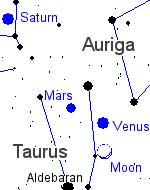
Image credit: NASA
It’s happening again: the Moon and a bunch of planets are gathering in the evening sky.
Unlike last month, when five bright planets (including Mercury) were visible, this time there are only four: Venus, Mars, Saturn and Jupiter. Four is plenty, though. Using only your eyes and, if you have one, a small telescope, you’ll be able to see some wondrous things.
The show begins on Thursday, April 22nd. Step outside after nightfall and look west. The first thing you’ll notice is piercing-bright Venus and, not far below it, the delicate crescent Moon. These are the two brightest objects in the night sky, pleasingly close together. Mars is there, too, albeit not much brighter than an ordinary star. You can find it just above Venus, at one vertex of a Moon-Mars-Venus isosceles triangle.
Point a telescope at Venus and ? it looks just like the Moon! Well, almost. Because it lies between Earth and the Sun, Venus has phases just as our Moon does. At the moment Venus is a fat crescent. It’s colored gray-white, very Moon-like, but unlike the Moon, Venus is featureless. Thick uniform clouds hide the planet’s surface; the most powerful telescopes on Earth can’t penetrate them.
The crescent Moon is more fun to look at through a telescope. Low-slanting rays from the sun cast long shadows from lunar mountains. You can see impact craters, valleys and rilles ? all cast into sharp relief.
Can you also see a ghostly glow across the Moon’s dark terrain? For millennia the glow was a mystery, until Leonardo da Vinci figured it out in the 16th century. It is sunlight reflected from Earth onto the Moon. Modern astronomers call the glow Earthshine, and it’s one of the loveliest sights in the heavens–no telescope required.
The triangle shifts on Friday, April 23rd, as the Moon moves past Venus to a spot right beside Mars. This is the best night to find Mars, dim and red, using the Moon as a guidepost. Seen through a telescope Mars is not very impressive, not like it was in August 2003 when the planet made a historic close approach to Earth.
On Saturday, April 24th, the Moon glides away from Mars and toward Saturn, which looks like a bright yellow star. With the Moon beside Saturn to mark its location, you can’t miss it. Point your telescope at Saturn: Even a small ‘scope will show the planet’s lovely rings and it’s biggest moon Titan.
The NASA-ESA Cassini spacecraft is en route to Saturn now, due to arrive in July. Cassini will orbit for four years, studying Saturn’s rings, weather and magnetic field. Cassini will also drop a probe named Huygens through the thick orange clouds of Titan to discover what lies beneath.
Titan is one of the most mysterious worlds in the solar system. It has a nitrogen atmosphere denser than Earth’s and clouds laced with organic compounds. Some researchers believe there might be puddles, lakes or even oceans of liquid hydrocarbons sloshing around on the surface. These are places where organic molecules might get together for the first stirrings of simple life.
Through a backyard telescope Titan looks like an 8th magnitude star, an unremarkable pinprick. In fact, Titan is bigger than Mercury and Pluto. If it orbited the sun it would surely be considered a planet. What do the clouds of Titan hide? It’s something to think about while you’re peering through the eyepiece.
Finally on Thursday, April 29th, the Moon glides by Jupiter. You’ve probably noticed Jupiter before: it hangs almost directly overhead at sunset and outshines everything in the sky except Venus and the Moon. The Moon and Jupiter side by side are a pleasing sight.
Look at Jupiter through a telescope and you’ll see the planet’s rust-colored cloud belts and its four largest moons: Io, Europa, Callisto, and Ganymede. You might also see the Great Red Spot–a hurricane twice as wide as Earth and at least 100 years old. On April 29th it will be crossing Jupiter’s middle (as seen from Earth) at 09:12 p.m. PDT or 04:12 UT on April 30th.
Four planets, six moons, Earthshine, lunar mountains, the phases of Venus, a planet-sized hurricane and Saturn’s rings: Mark your calendar and see them all before April is done.
Original Source: NASA Science Story
Arecibo Gets an Upgrade
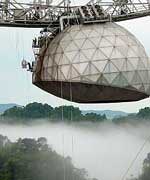
Image credit: Cornell
The Arecibo Observatory telescope, the largest and most sensitive single dish radio telescope in the world, is about to get a good deal more sensitive.
Today (Wednesday, April 21) the telescope got a new “eye on the sky” that will turn the huge dish, operated by Cornell University for the National Science Foundation, into the equivalent of a seven-pixel radio camera.
The complex new addition to the Arecibo telescope was hauled 150 meters (492 feet) above the telescope’s 1,000-foot-diameter (305 meters) reflector dish starting in the early morning hours. The device, the size of a washing machine, took 30 minutes to reach a platform inside the suspended Gregorian dome, where ultimately it will be cooled and then connected to a fiber optic transmission system leading to ultra-high speed digital signal processors. The new instrument is called ALFA (for Arecibo L-Band Feed Array) and is essentially a camera for making radio pictures of the sky. ALFA will conduct large-scale sky surveys with unprecedented sensitivity, enabling astronomers to collect data about seven times faster than at present, giving the telescope an even broader appeal to astronomers.
The ALFA receiver was built by the Australian research group, Commonwealth Scientific & Industrial Research Organisation, under contract to the National Astronomy and Ionosphere Center (NAIC) at Cornell, in Ithaca, N.Y. Development of ALFA was overseen by the observatory’s technical staff. The rest of the ALFA system, including ultra-fast data processing machines, are under development at NAIC.
Radio telescopes traditionally have been limited to seeing just one spot — a single pixel — on the sky at once. Pictures of the sky have been built up by painstakingly imaging one spot after another. But ALFA lets the telescope see seven spots — seven pixels — on the sky at once, slashing the time needed to make all-sky surveys. Steve Torchinsky, ALFA project manager at Arecibo Observatory, says the new device will make it possible to find many new fast-spinning, highly dense stars called pulsars and will improve the chances of picking up very rare kinds of systems — for instance, a pulsar orbiting a black hole.
It also will map the neutral hydrogen gas in our galaxy, the Milky Way, as well as in other galaxies. Hydrogen is the most abundant element in the universe. “A whole range of science is planned for ALFA, ” says Torchinsky. “Arecibo’s large collecting area is particularly well-suited to pulsar studies.”
NAIC commissioned CSIRO to build ALFA following the success of a ground-breaking “multibeam” instrument it had designed and built for the Parkes radio telescope in eastern Australia. That instrument increased the Parkes telescope’s view 13-fold, making it practical for the first time to search the whole sky for faint and hidden galaxies.
Original Source: Cornell News Release
Saturn in Four Wavelengths
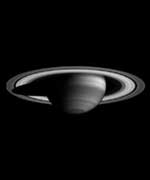
Image credit: NASA/JPL/Space Science Institute
A montage of Cassini images, taken in four different regions of the electromagnetic spectrum from the ultraviolet to the near-infrared, demonstrates that there is more to Saturn than meets the eye.
The pictures show the effects of absorption and scattering of light at different wavelengths by both atmospheric gas and clouds of differing heights and thicknesses. They also show absorption of light by colored particles mixed with white ammonia clouds in the planet’s atmosphere. Contrast has been enhanced to aid visibility of the atmosphere.
Cassini’s narrow-angle camera took these four images over a period of 20 minutes on April 3, 2004, when the spacecraft was 44.5 million kilometers (27.7 million miles) from the planet. The image scale is approximately 267 kilometers (166 miles) per pixel. All four images show the same face of Saturn.
In the upper left image, Saturn is seen in ultraviolet wavelengths (298 nanometers); at upper right, in visible blue wavelengths (440 nanometers); at lower left, in far red wavelengths just beyond the visible-light spectrum (727 nanometers); and at lower right, in near-infrared wavelengths (930 nanometers).
All gases scatter sunlight efficiently at short wavelengths. That’s why the sky on Earth is blue. The effect is more pronounced in the ultraviolet than in the visible. On Saturn, helium and molecular hydrogen gases scatter ultraviolet light strongly, making the atmosphere appear bright. Only high altitude cloud particles, which tend to absorb ultraviolet light, appear dark against the bright background, explaining the dark equatorial band in the upper left ultraviolet image. The contrast is reversed in the lower left image taken in a spectral region where light is absorbed by methane gas but scattered by high clouds. The equatorial zone in this image is bright because the high clouds there reflect this long wavelength light back to space before much of it can be absorbed by methane.
Scattering by atmospheric gases is less pronounced at visible blue wavelengths than it is in the ultraviolet. Hence, in the top right image, the sunlight can make its way down to deeper cloud layers and back to the observer, and the high equatorial cloud particles, which are reflective at visible wavelengths, also are apparent. This view is closest to what the human eye would see. At bottom right, in the near-infrared, some methane absorption is present but to a much lesser degree than at 727 nanometers. Scientists are not certain whether the contrasts here are produced mainly by colored particles or by latitude differences in altitude and cloud thickness. Data from Cassini should help answer this question.
The sliver of light seen in the northern hemisphere appears bright in the ultraviolet and blue (top images) and is nearly invisible at longer wavelengths (bottom images). The clouds in this part of the northern hemisphere are deep, and sunlight is illuminating only the cloud-free upper atmosphere. The shorter wavelengths are consequently scattered by the gas and make the illuminated atmosphere bright at these wavelengths, while the longer wavelengths are absorbed by methane.
Saturn’s rings also appear noticeably different from image to image, whose exposure times range from two to 46 seconds. The rings appear dark in the 46-second ultraviolet image because they inherently reflect little light at these wavelengths. The differences at other wavelengths are mostly due to the differences in exposure times.
The Cassini-Huygens mission is a cooperative project of NASA, the European Space Agency and the Italian Space Agency. The Jet Propulsion Laboratory, a division of the California Institute of Technology in Pasadena, manages the Cassini-Huygens mission for NASA’s Office of Space Science, Washington, D.C. The Cassini orbiter and its two onboard cameras, were designed, developed and assembled at JPL. The imaging team is based at the Space Science Institute, Boulder, Colorado
For more information about the Cassini-Huygens mission, visit http://saturn.jpl.nasa.gov and the Cassini imaging team home page, http://ciclops.org.
Original Source: CICLOPS News Release
Book Review: Einstein’s Cosmos
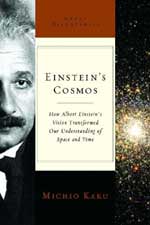
Perhaps surprisingly Einstein had a less than spectacular youth. He appeared to be more interested in reading books than developing social skills. He also had his own value system that gave greater weight to substance than imagery. From this he completed his undergraduate work with no money, no support for further education and few friends to start him on a career. Luckily one of them did find him a posting as a government patent officer. As he excelled at analyzing propositions, the work suited him. Of greater benefit was the opportunity he had to freely think about many of the questions that had been perplexing him since his early years. Through discussions with new colleagues and fortuitous circumstances in one year, 1905, he wrote his theories on special relativity, the interchangeability of matter and energy and the quantization of light. With these Einstein finally received support from the scientific community together with a doctorate and a teaching position at a university.
In as much as these theories were ground breaking postulations of their time, Einstein didn’t rest on his laurels. Much of his preceding work had been on the contemplation of light and the electromagnetic effect. Einstein’s conjectures about light were for the most part based in the nether regions of space where there was no effect from gravity. His general theory on relativity brought gravity into perspective by describing it as the bending of space and time. As Einstein was now a full member of the scientific community he instantly got support and tribulations from his colleagues. Though this was and still is the accepted method for evaluating new theories it seemed quite vicious and even somewhat personal. Nevertheless his theory prevailed with much support from a field he was not particularly good at, mathematics. In reviewing Einstein’s work mathematicians corroborated his theories and perhaps more importantly expanded them to encompass other known yet unexplained phenomena.
It was at about this time that Einstein’s fame blossomed. He went on world tours, was greeted by royalty and had the adulation usually reserved for film stars. He even saw his face depicted in stained glass at a church to which he mused, “a jew as a protestant saint?”. Aside from these existential considerations, Einstein was facing more suitable cosmological challenges. For example, if gravity is an attractive force shouldn’t the universe be contracting, eventually leading to a singularity? Einstein with the scientific community tackled this and others. Schwarzschild’s solution to Einstein’s equations led to event horizons and black holes. Mandl brought forward the idea of testing gravity by looking for the lensing of light caused by the mass of stars. These and others put Einstein’s theories to the test and continually they were found up to the task. He was due his fame.
Still Einstein continued. The jewel in the crown so to speak was the unifying theory. That is, a field theory that unified his theory of gravity with Maxwell’s theory of electromagnetism. Unity would bring together the farthest reaches of the cosmos with the smallest concepts of particles in a sensible temporal frame. Much of the last thirty years of Einstein’s life was spent looking for this theory. Mathematics shone as the tool of choice as only it could successfully represent the relations of objects too small and obscure or too large and too powerful. Yet even with this Einstein met his match. As Kaku put it, Einstein was about 50 years ahead of the necessary technology and mathematics to continue making progress.
This book by Kaku is a clean concise summary of Einstein’s activities portrayed against the technical and political challenges of the day. Kaku also discusses recent experiments that have or will provide more proof or insight. The progression from Newtonian thinking of space and time to relativistic thinking admirably describes scientific progress and the rigour to which theories are subject.
In some ways though this book may make you feel like a child in a candy store. There are many referrals to experiments and mathematical properties but no substantiation. If you know the material, the reading is easy, if you don’t you need faith or must investigate elsewhere. Also, the portrayal of Einstein is one sided in that only his positive attributes seem to be mentioned. Everyone has their off days and in adding some of Einstein’s, the portrayal would have been more balanced.
All in all, Einstein’s Cosmos aptly describes Einstein as the amazing person he was who readily deserves the praise of being one of the most influential people of the millennium. As we each age and travel with our planet through space we should take some of the precious time we are granted on Earth to read books like this and perhaps realize a clearer view of where we stand and what we can accomplish.
Buy this book and others from Amazon.com
Review by Mark Mortimer
Wallpaper: Galaxy with a Ring of Star Formation
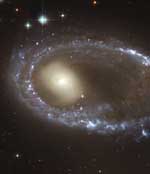
Image credit: Hubble
Resembling a diamond-encrusted bracelet, a ring of brilliant blue star clusters wraps around the yellowish nucleus of what was once a normal spiral galaxy in this new image from NASA’s Hubble Space Telescope (HST). This image is being released to commemorate the 14th anniversary of Hubble’s launch on April 24, 1990 and its deployment from the space shuttle Discovery on April 25, 1990.
The sparkling blue ring is 150,000 light-years in diameter, making it larger than our entire home galaxy, the Milky Way. The galaxy, cataloged as AM 0644-741, is a member of the class of so- called “ring galaxies.” It lies 300 million light-years away in the direction of the southern constellation Dorado.
Ring galaxies are an especially striking example of how collisions between galaxies can dramatically change their structure, while also triggering the formation of new stars. They arise from a particular type of collision, in which one galaxy (the “intruder”) plunges directly through the disk of another one (the “target”). In the case of AM 0644-741, the galaxy that pierced through the ring galaxy is out of the image but visible in larger-field images. The soft spiral galaxy that is visible to the left of the ring galaxy in the image is a coincidental background galaxy that is not interacting with the ring.
The resulting gravitational shock imparted due to the collision drastically changes the orbits of stars and gas in the target galaxy’s disk, causing them to rush outward, somewhat like ripples in a pond after a large rock has been thrown in. As the ring plows outward into its surroundings, gas clouds collide and are compressed. The clouds can then contract under their own gravity, collapse, and form an abundance of new stars.
The rampant blue star formation explains why the ring is so blue: It is continuously forming massive, young, hot stars, which are blue in color. Another sign of robust star formation is the pink regions along the ring. These are rarefied clouds of glowing hydrogen gas, fluorescing because of the strong ultraviolet light from the newly formed massive stars.
Anyone who lives on planets embedded in the ring would be treated to a view of a brilliant band of blue stars arching across the heavens. The view would be relatively short-lived because theoretical studies indicate that the blue ring will not continue to expand forever. After about 300 million years, it will reach a maximum radius, and then begin to disintegrate.
The Hubble Heritage Team used the Hubble Advanced Camera for Surveys to take this image in January 2004. The team used a combination of four separate filters that isolate blue, green, red, and near-infrared light to create the color image.
The Space Telescope Science Institute (STScI) is operated by the Association of Universities for Research in Astronomy, Inc. (AURA), for NASA, under contract with the Goddard Space Flight Center, Greenbelt, MD. The Hubble Space Telescope is a project of international cooperation between NASA and the European Space Agency (ESA).
Original Source: Hubble News Release
Not Getting the Newsletter?
In theory, I send out Universe Today every weekday (Mon-Fri) some time during the day. I do occasionally miss a day, but for the last year or so, that’s been pretty rare. If you find the newsletter just stops coming, you should be suspicious that your Internet service provider has gotten a little over-zealous in its attempts to block SPAM. This newsletter has images in it, and allows you to unsubscribe – and these are also key features of a lot of unsolicited mail.
So, if Universe Today doesn’t show up in your mailbox, wait a couple of days and then check the website. If the homepage hasn’t been updated, then it means I’m not working on the website… bad Fraser! But if I am being industrious and the homepage is current, that means the newsletter is going out. Time for you to nag your Internet service provider.
Check to see if the email is being dumped into your junk mail folder. It’s got a different name in Hotmail, AOL, Yahoo, etc. If it’s not there, you should have some way make sure that mail from me is never considered SPAM. If that doesn’t seem to be working, you’ll have to contact your ISP through email or on the phone and let them know that you really miss your subscription to Universe Today. Send me an email and I can try and work on them from my end as well.
Thanks!
Fraser Cain
Publisher
Universe Today
P.S. I’ve getting reports from Yahoo folks that the newsletter is being blocked as of April 14th. If anyone knows what happened, please enlighten me so I can fix it.
Are Jupiter’s Spots Disappearing?
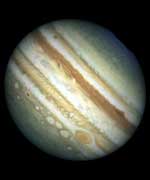
Image credit: NASA/JPL
If a University of California, Berkeley, physicist’s vision of Jupiter is correct, the giant planet will be in for a major global temperature shift over the next decade as most of its large vortices disappear.
But fans of the Great Red Spot can rest easy. The most famous of Jupiter’s vortices – which are often compared to Earth’s hurricanes – will stay put, largely because of its location near the planet’s equator, says Philip Marcus, a professor at UC Berkeley’s Department of Mechanical Engineering.
Using whirlpools and eddies for comparison, Marcus bases his forecast on principals learned in junior-level fluid dynamics and on the observation that many of Jupiter’s vortices are literally vanishing into thin air.
“I predict that due to the loss of these atmospheric whirlpools, the average temperature on Jupiter will change by as much as 10 degrees Celsius, getting warmer near the equator and cooler at the poles,” says Marcus. “This global shift in temperature will cause the jet streams to become unstable and thereby spawn new vortices. It’s an event that even backyard astronomers will be able to witness.”
According to Marcus, the imminent changes signal the end of Jupiter’s current 70-year climate cycle. His surprising predictions are published in the April 22 issue of the journal Nature.
Jupiter’s stormy atmosphere has a dozen or so jet streams that travel in alternating directions of east and west, and that can clock speeds greater than 330 miles per hour. As on Earth, vortices on Jupiter that rotate clockwise in the northern hemisphere are considered anticyclones, while those that spin counterclockwise are cyclones. The opposite is true in the southern hemisphere, where clockwise vortices are cyclones and counterclockwise spinners are anticyclones.
The Great Red Spot, located in the southern hemisphere, holds title as Jupiter’s largest anticyclone; spanning 12,500 miles wide, it is large enough to swallow Earth two to three times over.
Unlike the cyclonic storms on Jupiter, Earth’s hurricanes and storms are associated with low-pressure systems and dissipate after days or weeks. The Great Red Spot, in comparison, is a high-pressure system that has been stable for more than 300 years, and shows no signs of slowing down.
About 20 years ago, Marcus developed a computer model showing how the Great Red Spot emerged out of and endured in the chaotic turbulence of Jupiter’s atmosphere. His efforts to explain the dynamics governing it and other vortices on Jupiter led to his current projection of the planet’s impending climate change.
He says the current 70-year cycle began with the formation of three distinct anticyclones – the White Ovals – that developed south of the Great Red Spot in 1939. “The birth of the White Ovals was seen through telescopes on Earth,” he says. “I believe we’re in for a similar treat within the next 10 years.”
Marcus says the first stage of the climate cycle involves the formation of vortex streets which straddle the westward jet streams. Anticyclones form on one side of the street, while cyclones form on the other side, with no two vortices rotating in the same direction directly adjacent to each other.
Most of the vortices slowly decay with turbulence. By stage two of the cycle, some vortices become weak enough to get trapped in the occasional troughs, or Rossby waves, that form in the jet stream. Multiple vortices can get caught in the same trough. When they do, they travel bunched together, and turbulence can easily make them merge. When the vortices are weak, trapping and merging continues until only one pair is left on each vortex street.
The noted disappearance of two White Ovals, one in 1997 or 1998 and a second in 2000, exemplified the merging of the vortices in stage two, and as such, signaled the “beginning of the end” of Jupiter’s current climate cycle, says Marcus.
Why would the merger of vortices affect global temperature? Marcus says the relatively uniform temperature of Jupiter – where the temperatures at the poles are nearly the same as they are at the equator – is due to the chaotic mixing of heat and airflow from the vortices.
“If you knock out a whole row of vortices, you stop all the mixing of heat at that latitude,” says Marcus. “This creates a big wall and prevents the transport of heat from the equator to the poles.”
Once enough vortices are gone, the planet’s atmosphere will warm at the equator and cool at the poles by as much as 10 degrees Celsius in each region, which is stage three of the climate cycle.
This temperature change destabilizes the jet streams, which will react by becoming wavy. The waves steepen and break up, like they do at the beach, but they then roll up into new large vortices in the cycle’s fourth stage. In the fifth and final stage of the climate cycle, the new vortices decrease in size, and they settle into the vortex streets to begin a new cycle.
The weakening of the vortices is due to turbulence and happens gradually over time. It takes about half a century for newly formed vortices to gradually shrink down enough to be caught up in a jet stream trough, says Marcus.
Fortunately, the Great Red Spot’s proximity to the equator saves it from destruction. Unlike Jupiter’s other vortices, the Great Red Spot survives by “eating” its neighboring anticyclones, says Marcus.
Marcus notes that his theory of Jupiter’s climate cycle relies on the existence of a roughly equal number of cyclones and anticyclones on the planet.
Since the telltale signs of vortices are the clouds they create, it was easy to miss the presence of long-lived cyclones, says Marcus. He explains that unlike an anticyclone’s distinct spot, cyclones create patterns of filamentary clouds that are less clearly defined.
“On the face of it, it is easy to think that Jupiter is dominated by anticyclones because their spinning clouds show up clearly as bull’s-eyes,” says Marcus.
In the paper in Nature, Marcus presents a computer simulation showing that the warm center and cooler perimeter of a cyclone creates the appearance of the filamentary clouds. In contrast, anticyclones have cold centers and warmer perimeters. Ice crystals that form in the anticyclone’s center swell up and move to the sides where they melt, creating a darker swirl surrounding a lighter colored center.
Marcus approaches the study of planetary atmospheres from the untraditional viewpoint of a fluid dynamicist. “I’m basing my predictions on the relatively simple laws of vortex dynamics instead of using voluminous amounts of data or complex atmospheric models,” says Marcus.
Marcus says the lesson of Jupiter’s climate could be that small disturbances can cause global changes. However, he cautions against applying the same model to Earth’s climate, which is influenced by many different factors, both natural and manmade.
“Still, it’s important to have different ‘labs’ for climate,” says Marcus. “Studying other worlds helps us better understand our own, even if they are not directly analogous.”
Marcus’s research is supported by grants from the NASA Origins Program, the National Science Foundation Astronomy and Plasma Physics Programs and the Los Alamos National Laboratory.
Original Source: UC Berkeley News Release
